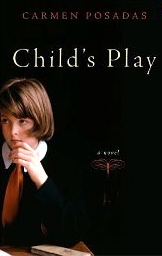““The most infallible philosophical theory on human nature is the one “[a friend] relishes: what he calls ‘The Julio Iglesias Theory.’ According to this, people behave exactly as the song says: ‘Sometimes yes, sometimes no, sometimes you, sometimes me…’”
The first sev eral pages of this Spanish gothic melodrama might be enough to discourage even the most intrepid reader—overblown prose, trite imagery, clichés, self-conscious attempts to play on the reader’s heartstrings, and an undeniable straining for “effect.” Then in a twist, the reader discovers that this excerpt is merely the beginning of a manuscript about a child murder written by Luisa Davila, the main character in the larger novel. And just as the reader is saying “Whew,” at the thought of having escaped three hundred pages of such writing, the author introduces us to Luisa, a Madrid single mother who has written several successful mysteries starring her two detective heroes, psychoanalyst Carmen O’Inns and her partner Isaac Tonnu. Luisa, aged fifty-two and gifted with a “rampant imagination,” has just moved into a new Madrid apartment with her eleven-year-old daughter Elba, named for the island where Luisa, then aged forty, conceived her while on a “mating trip.” The new apartment will allow Elba to attend the private English High School which Luisa attended as a child.
eral pages of this Spanish gothic melodrama might be enough to discourage even the most intrepid reader—overblown prose, trite imagery, clichés, self-conscious attempts to play on the reader’s heartstrings, and an undeniable straining for “effect.” Then in a twist, the reader discovers that this excerpt is merely the beginning of a manuscript about a child murder written by Luisa Davila, the main character in the larger novel. And just as the reader is saying “Whew,” at the thought of having escaped three hundred pages of such writing, the author introduces us to Luisa, a Madrid single mother who has written several successful mysteries starring her two detective heroes, psychoanalyst Carmen O’Inns and her partner Isaac Tonnu. Luisa, aged fifty-two and gifted with a “rampant imagination,” has just moved into a new Madrid apartment with her eleven-year-old daughter Elba, named for the island where Luisa, then aged forty, conceived her while on a “mating trip.” The new apartment will allow Elba to attend the private English High School which Luisa attended as a child.
What follows is an unusual variation of metafiction, in which Luisa simultaneously creates her over-the-top novel about the death of a child at a private school, describes the similar death of a child forty years ago when she herself was an eleven-year-old student at her private school, and then relates details about another remarkably similar death of a child at the same private school during the time that her daughter Elba is a student. Three young boys. Three deaths. Three mysteries.
When Luisa takes Elba to school on the first day, she expects that there will be no one she recognizes from the past—after all, she is older than most of the parents of children of Elba’s age by about ten years. Yet, amazingly, she finds that her best friend from school, Sofia Marquez, is going to be Elba’s teacher, and even more amazingly, that Sofia’s daughter Avril, is not only in the same class but is about to become Elba’s best friend. When Luisa was a child, she, Sofia, Miguel Gasset, and his more talented identical twin Antonio Gasset, were constantly together, until Antonio fell, broke his neck, and died, an accident that Luisa has still not fully reconciled. She also discovers that Miguel, the third living member of the group, now the survivor of four marriages, has a son Miguel (“Miki”) who is also in the same class at school. When Miki dies soon afterward in a similar fall at school, Luisa’s imagination works overtime as she tries to remember all the details about Antonio’s death and then tries to find out more information about the similar death of Miki.
constantly together, until Antonio fell, broke his neck, and died, an accident that Luisa has still not fully reconciled. She also discovers that Miguel, the third living member of the group, now the survivor of four marriages, has a son Miguel (“Miki”) who is also in the same class at school. When Miki dies soon afterward in a similar fall at school, Luisa’s imagination works overtime as she tries to remember all the details about Antonio’s death and then tries to find out more information about the similar death of Miki.
Everyone she has ever known, including Sofia, Miguel, Elba’s best friend Avril, and even Elba herself come under Luisa’s scrutiny as she tries to decide if someone she has loved could possibly be a murderer. In the meantime, Luisa, a sexually liberated woman, has an affair with someone about whom she is unsure, maintains her relationship with a long-time lover, and tries to be a role model for Elba, who is sexually precocious at age eleven, with a fondness for Antonio, the 28-year-old son of Luisa’s friend Miguel, twin brother of the victim from a generation ago. The several investigations on three different levels—the imagined story, the death from forty years ago, and the recent death of Miki—all lead to Luisa’s lengthy analysis of people, how they respond to frustration, and the extremes to which they might be driven if provoked.
Author Carmen Posadas, born in Uruguay, recently becoming a Spanish citizen, explores and analyzes all the people involved in this fraught situation, using Luisa (who greatly resembles Posadas in background) to reflect her uncertainties, never sure whether she is hearing the truth, whether she is imagining complications where they do not exist, and whether she is suspecting innocent people, including her own daughter, of heinous acts. The reader, in turn, is never quite sure whether Luisa herself can be trusted to be an impartial observer. On many occasions, the author provides three sentences of analysis and equivocating where one would do, and raises questions which cast doubt on what might be innocent actions on the part of other characters. By the time the novel ends and the deaths have been analyzed on the levels of all three subplots, the reader has come to believe fully in the philosophy of Julio Iglesias: ‘Sometimes yes, sometimes no, sometimes you, sometimes me…’” A novel which proves that gothic melodrama is still alive and well, Child’s Play raises many questions, and each reader will have to decide the extent to which these are resolved—perhaps concluding “Sometimes yes, sometimes no.”
Notes: The author’s photo appears here: http://commons.wikimedia.org/wiki/File:CarmenPosadas.jpg
